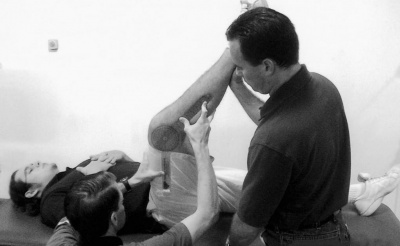Passive Knee Extension Test
Original Editor - Your name will be added here if you created the original content for this page.
Lead Editors
Purpose
[edit | edit source]
The purpose of the Passive knee extension test is to measure tightness of the hamstring muscles [1]
Technique
[edit | edit source]
The patient is positioned supine with the hip of the tested leg in 90 of flexion.The contralateral leg stays flat on the examination table. the clinician extends the knee until reaching the maximal tolerable stretch of the hamstring muscle as indicated by the patient , with the ipsilateral hip remaining in 90 of flexion. The knee angle is then measured. [2]
Evidence[edit | edit source]
Provide the evidence for this technique here
Resources[edit | edit source]
add any relevant resources here
Recent Related Research (from Pubmed)[edit | edit source]
Failed to load RSS feed from http://www.ncbi.nlm.nih.gov/entrez/eutils/erss.cgi?rss_guid=1JAk5IMbg5byNMHDKdX1SZ3YC4Zn8x0dl2BhiTif4ao8QeAI1n|charset=UTF-8|short|max=10: Error parsing XML for RSS
References[edit | edit source]
References will automatically be added here, see adding references tutorial.
- ↑ Fredriksen H, Dagfinrud H, Jacobsen V, Maehlum S. Passive knee extension test to measure hamstring muscle tightness. Scandinavian journal of medicine & science in sports. 1997 Oct 1;7(5):279-82.
- ↑ Reurink G, Goudswaard GJ, Oomen HG, Moen MH, Tol JL, Verhaar JA, Weir A. Reliability of the active and passive knee extension test in acute hamstring injuries. The American journal of sports medicine. 2013 Aug 1;41(8):1757-61.
- ↑ Nelson RT, Bandy WD. Eccentric training and static stretching improve hamstring flexibility of high school males. Journal of athletic training. 2004 Jul 1;39(3):254.







